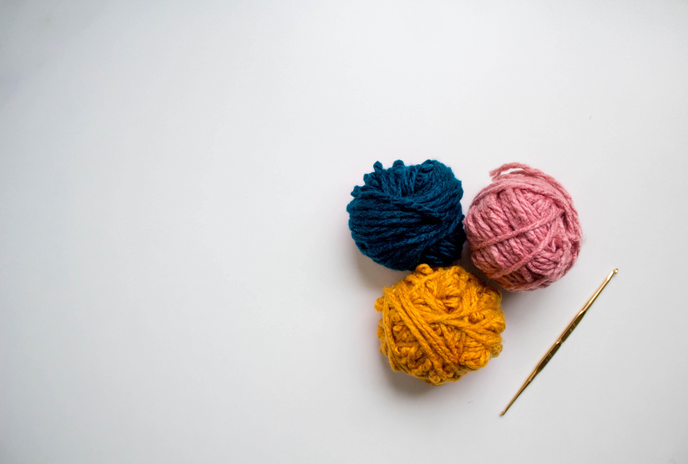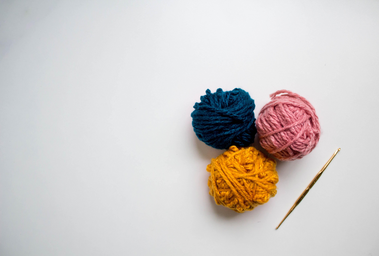‘Tis the season for handmade gifts, craft shows, and cozying up in the evening with a good project. With that, I thought I’d share with you my favorite crafting project: crocheting. Crocheting is similar to knitting as they both loop together yarn into textile creations. You can make hats, scarfs, blankets, mittens, even keychains! The possibilities are endless and creative. Currently, I’m working on a pair of fingerless gloves with a convertible mitten flap!
Supplies
Crocheting uses a hook to literally “hook” together yarn. These hooks range in size depending on what is appropriate for the project. For example, a blanket made with chunky yarn will require a larger (thicker) hook than, say, gloves with an intricate pattern. To get started with basic crocheting, any size hook will do, but size 5-7mm is probably easiest.
You’ll also need yarn. Yarn is a whole thing, and can be found with prices ranging from $1 a skane to much more than that. Yarn is made from all sorts of material, including alpaca and bamboo, but the most standard types (and most accessible to folks just starting out), are wool and acrylic blends. Just be aware that wool shrinks! Aside from the material the yarn is made out of, you’ll also need to be aware of yarn weights. Yarn weights are classed on a scale of 0-7, with 0 being lace, and 7 being jumbo. The most versatile weight is about 4 (medium), which is where I’d recommend starting.
With a decent weighted yarn and a hook, you’ll be able to see your stitches nicely and find where you’ll be inserting your hook without too much unnecessary confusion. An acrylic blend, light-colored yarn is best for your first project. Both hooks and yarn can be purchased at Michael’s craft stores or online. In order to begin working with the yarn, you’ll need to reroll it from the skane (how it is sold) into a ball. A ball is much easier to work with and rerolling the yarn allows you to work through any tangles prior to beginning your project.
Basic Stitches
Once you have all the necessary equipment, you can begin to learn to crochet. There are, of course, more advanced supplies you can purchase, like yarn needles, but those are not necessary when you’re just beginning. Linked is a nice video that explains the basic single crochet stitch. With an understanding of this stitch, you can gain confidence and build your skills from there.
In addition to the single crochet stitch, common crochet stitches include the double crochet, the half double crochet, and a slip stitch. I’ve linked a YouTube playlist of excellent explanatory videos on the basics. It is nearly impossible to teach crocheting in an article, so I’ll hand the baton to YouTube. You’ll also want to gain confidence working in the round. This is a good tutorial that demonstrates it.
While you’re getting the hang of crocheting, it is likely easiest to just play around with the yarn without a specific project in mind. You will make mistakes and that’s okay! An easy way to avoid frustration is to keep your expectations low and just experiment.
Patterns
Once you gain some confidence, you can move on to working on patterns. Crochet patterns are basically the instructions for projects. Many are available for free online.
As you read patterns, you’ll notice some hooks are referred to by their US Hook Size, while some are referred to by their millimeter size. Take a peek at the chart below to figure out which hook you need.
| US Crochet Hook Size | Metric/Millimeter (mm) |
| B/1 | 2.25 |
| C/2 | 2.75 |
| D/3 | 3.25 |
| E/4 | 3.5 |
| F/5 | 3.75 |
| G/6 | 4.0 |
| 7 | 4.5 |
| H/8 | 5.0 |
| I/9 | 5.5 |
| J/10 | 6.0 |
| K/10.5 | 6.5 |
| L/11 | 8.0 |
| M/13 | 9.0 |
| N/15 | 10.0 |
| P | 15.0 |
| Q | 16.0 |
| S | 19.0 |
Below you’ll find some patterns I encourage you to check out. I’ve included some notes about each one you may find helpful.
HALF DOUBLE PRECIOSA SCARF by Hannah Maier: This pattern is worked in long rows of half double crochets through the back loop of your chain (abbreviated by “hdcblo”). You’ll need 2 skanes of medium number 4 yarn. The pattern recommends Merino wool, but you can use any yarn you have or are comfortable working with as long as it is the right weight. Lion Brand Wool Ease yarn is a simple personal favorite if you’re looking for recommendations.
Easy Peasy Pompom Crochet Coaster: This is an incredibly simple pattern for adorable coasters. Using a medium weight number 4 yarn, this pattern is worked exclusively with single crochets (abbreviated as “sc”), so it’s the perfect pattern to start off with.
30 Minute Beanie: This pattern is a whole hat! Using the same medium weight number 4 yarn, it has the potential to be a little challenging and involves double crochets (abbreviated as “dc”), slip stitches (abbreviated as “sl st”), the magic circle (i.e. working in the round to start off), and increasing stitch counts as the hat grows from the top down. With that being said, it’s totally manageable, and I believe in you! Use YouTube as a resource for any stitches you don’t quite understand.
Hopefully, this little guide gave you an introduction to everything you need to know to get started crocheting. It may seem very overwhelming at first, but I assure you, with a little practice you’ll be crocheting away! Crochet is a very easy thing to teach yourself using the internet, and you have a lot of room for creativity and advancement. Now get stitching!
Can’t get enough of HC UMass Amherst? Be sure to follow us on Instagram, listen to us on Spotify, like us on Facebook, and read our latest Tweets!


